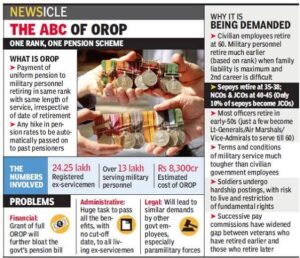Published on: March 17, 2022
ONE RANK – ONE PENSION
ONE RANK – ONE PENSION
NEWS
The Supreme Court upheld the Centre’s one rank, one pension (OROP) scheme for the armed forces
THE SCHEME
CURRENT SYSTEM OF PENSION
- Depends on the last salary drawn
- Fifty percent of the last salary drawn is typically the pension over and above which you get the other allowances
ISSUES IN CURRENT SYSTEM
- Due to the present model of pension, a lieutenant general who retired in 1995 will get a pension that is 10% lower than a colonel who retired after 2006
- Similarly, a jawan who retired in 1995 will get a pension which is 80% less than his counterpart who retired on or after 1 January 2006
SALIENT FEATURES
- Implies uniform pension to personal based on rank and length of service, irrespective of the date of retirement.
- The implementation of the scheme was based on recommendation of the Koshiyari committee.
- Pension of past pensioners would be re-fixed on the basis of pension of retirees of calendar year 2013 and the benefit will be effective from 01.07.2014
- Pension will be re-fixed for all pensioners on the basis of the average of minimum and maximum pension of personnel retired in 2013 in the same rank and with same length of service.
- Pension for those drawing above average shall be protected.
- Arrears will be paid in four equal half yearly instalments. However, all the family pensioners including those in receipt of Special/Liberalized family pension and Gallantry award winners shall be paid arrears in one instalment.
- Pension would be re-fixed every 5 years
ARGUMENTS IN FAVOUR
- The defence personnel is made to retire at the age of 33 to 35 years due to the necessity of maintaining a younger army whereas the officer of civil side retires at the age of 60 years.
- It is the moral obligation of the state to look after the welfare of the soldiers who served the nation.
- A lowered pay status compared to the civilian counterparts with less period of service affects the morale of forces.
- The issues, veterans emphasize, are of justice, equity, honor, and national security.
THE CHALLENGES
- Financial hurdle as the estimated time cost of implementation is 8000-10000 crore rupees. This will increase on every further revision of salary.
- Expenditure on arrears would be around 10000 crore rupees.
- Lead to demands from other army personnel like CRPF, CISF etc.
- It is also an administrative challenge due to lack of records going back to many decades.

